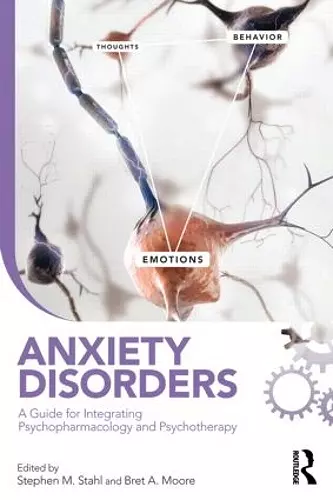Anxiety Disorders
A Guide for Integrating Psychopharmacology and Psychotherapy
Stephen M Stahl editor Bret A Moore editor
Format:Paperback
Publisher:Taylor & Francis Ltd
Published:13th Feb '13
Currently unavailable, and unfortunately no date known when it will be back
This paperback is available in another edition too:
- Hardback£175.00(9780415509824)

Drs. Stephen M. Stahl and Bret A. Moore have created an instant classic in Anxiety Disorders: A Guide for Integrating Psychopharmacology and Psychotherapy. Anxiety Disorders is a comprehensive reference for the psychiatry and psychology student, intern, or resident, early career psychiatrist or psychologist, and the busy clinician. It distills the most important information regarding combined treatments for anxiety and presents the material in an easily accessible, understandable, and readable format. Each chapter addresses a specific type of disorder: PTSD, panic, generalized anxiety, obsessive-compulsive and other disorders, and is authored by prominent clinicians with years of experience in providing integrated, individualized treatments. With its thorough exploration of psychopharmacological treatments, psychosocial treatments, and, crucially, the integration of the two, Anxiety Disorders is a text no 21st-century clinician or student can afford to be without.
"The confluence of emerging scientific insights and continued unmet clinical need make this book, examining the integration of psychopharmacology and psychotherapy for the treatment of anxiety disorders, and edited by experts in these areas, timely and critical to our evolving understanding of the treatment of the anxiety disorders and the goal of optimizing the well-being of our affected patients."
– Mark H. Pollack, MD, Grainger Professor and Chairman, Department of Psychology, Rush University Medical Center, Chicago, IL
"Stephen Stahl and Bret Moore should be commended for Anxiety Disorders. This volume covers it all—from children’s sleep problems to veteran’s PTSD, from alprazolam to virtual reality, and everything in between. All of the psychosocial interventions are covered, as is each class of medications, even including nutritional and herbal supplements, with the empirical support for each. This is a must-read for any practitioner treating anxiety, and students and trainees will gain a lifetime of experience in one easy read."
—Barbara O. Rothbaum, PhD, ABPP, professor in psychiatry and director of the Trauma and Anxiety Recovery Program at the Emory University School of Medicine
"Where many books address only the use of medication or psychotherapy for anxiety, the expert panel of authors in this volume has approached the study of anxiety from a truly biopsychosocial perspective, focusing on the integration and selective use of both pharmaceutical and psychotherapeutic treatments. This text is a valuable tool for the clinician who must do treatment planning in the real world."
—Robert McGrath, PhD, professor at Fairleigh Dickinson University and director of the MS program in clinical psychopharmacology
"The editors have done a real service by compiling a volume that does not presume the primacy of either drugs or psychotherapy in the treatment of anxiety disorders. Chapters on each specific disorder are well grounded in science, contain helpful clinical points, and are refreshingly free of guild-specific biases. A worthwhile addition for those clinicians working with anxiety disorders."
—Morgan T. Sammons, PhD, ABPP, dean of the California School of Professional Psychology
"A very useful, scientifically-based guide for clinicians of all disciplines treating clients for a range of anxiety disorders. The case examples and "clinical points" are particularly insightful. A sensitive balance between behavioral and medication options."
—Pat DeLeon, former president of the American Psychological Association.
"Each chapter is written in a clear and engaging style, with useful vignettes of believable patients who represent the problems of both resistance to, and complexity of, treatment, and also show the successes of combined treatment. The book flirts with the reader and may entice them into using joint treatments more appropriately and represents a good start to a new genre of publications."
—Peter Tyrer, The British Journal of Psychiatry
ISBN: 9780415509831
Dimensions: unknown
Weight: 428g
312 pages